Our most faithful readers know about the little swamp which we maintain at weedom for the spring peepers and other frogs that presage the coming of Spring. It also feeds some weedy willow trees, which we chop regularly and vigorously so that they don’t drain the swamp before the frogs have accomplished their reproductive mission. Removing the trees entirely is probably not possible without large equipment, and we don’t want to disturb the frog jungle too much. Besides, willows are incredibly useful as medicine so it’s good to keep them around. Most of the hundreds of willow species have some useful medicinal compounds to offer. Some say there are 300-500 species, but they’re only guessing. Willows are able to hybridize, and the cultivars can vary hugely in appearance. Our willow weeds, certainly don’t look like trees because of what we do to them, but would be 50-70 feet tall and tangling our electric lines if we allowed them to take their natural shape. Over the years, many of these willows had attained full maturity along the main creek that travels through the farm.
Willow species have gained fame for thousands of years as medicine for the relief of fevers and pain, as an astringent and anti-inflammatory. Most attention has been accorded to the inner bark of the plants which is available in all seasons. But innumerable other compounds have been found in the leaves and flowers of willow species, which are more assiduously studied by our pharmacognosy friends halfway around the world, and which certainly contribute to their medicinal effects. Willow yields salicin, a glycoside which is found in numerous species of Salix, Populus, and Spiraea genera, for examples. When Felix Hoffman made aspirin, (the name means ‘from Spiraea’) he utilized salicin from meadowsweet, Spiraea ulmaria, which is now called Filipendula ulmaria. This plant is a more efficient producer than the willows, from which the compound was first isolated in 1828. Though willows probably remain the most famous source, salicin can be obtained more easily from the meadowsweet. Of the willows, Salix amplexicaulis, native to Europe, and Salix purpurea, a shrub with blue-green leaves, yield the most salicin.
The weed willows that border our swamp, with their green older stems, and green leaves with white undersides, are a type of white willow, Salix alba, of the family Salicaceae. Salix alba is native to Europe and Asia, but many cultivars have fully escaped gardens and landscapes, since migrating to the U.S. in the 1700s, and they’re well distributed throughout this country. At this time of year, (early April) the floral catkins have emerged with the early leaves. Willows are generally dioecious, with male flowers and female flowers on separate trees. Catkins of female flowers are an between 1 and 2 inches (2.5-5 cm) long are visible on the tree shown below which has recently sprouted its leaves. The male floral catkins have a similar arrangment but more yellow color.
Later in the spring, the lanceolate leaves of this tree show a more distinctive white, silky underside, as they mature, but a distinct color difference between the top and bottom of the leaves is apparent even now. The leaves, 2-3 inches (5-7 cm.) long appear alternately on the stems, on short petioles. They are pinnately veined, and bear very small teeth on the borders.
The newest stems are a very light green, and twigs from last year’s growth are a gold tinged green, and can even appear orange depending on the light. Older stems are a smooth green, then eventually become furrowed and take on a brown or grayish brown color if we fail to cut them for many years. Widely spaced lenticles (for air exchange) are visible on the twigs and stems. We note that the stems bud from the sides, and there is no terminal bud.
The white willow is comfortable in disturbed soils, near or in water, in USDA hardiness zones 2-9. Most of the willow species do best in full sun, and they’re considered pioneer species: the first trees to invade an open area of land. Probably the only way to kill a willow is to remove the water supply. We have left cut branches or trunks lying horizontally on the ground for too long, and they sprouted branches above, and roots below. We can chop our willows to the ground, and new branches will grow from the stumps.
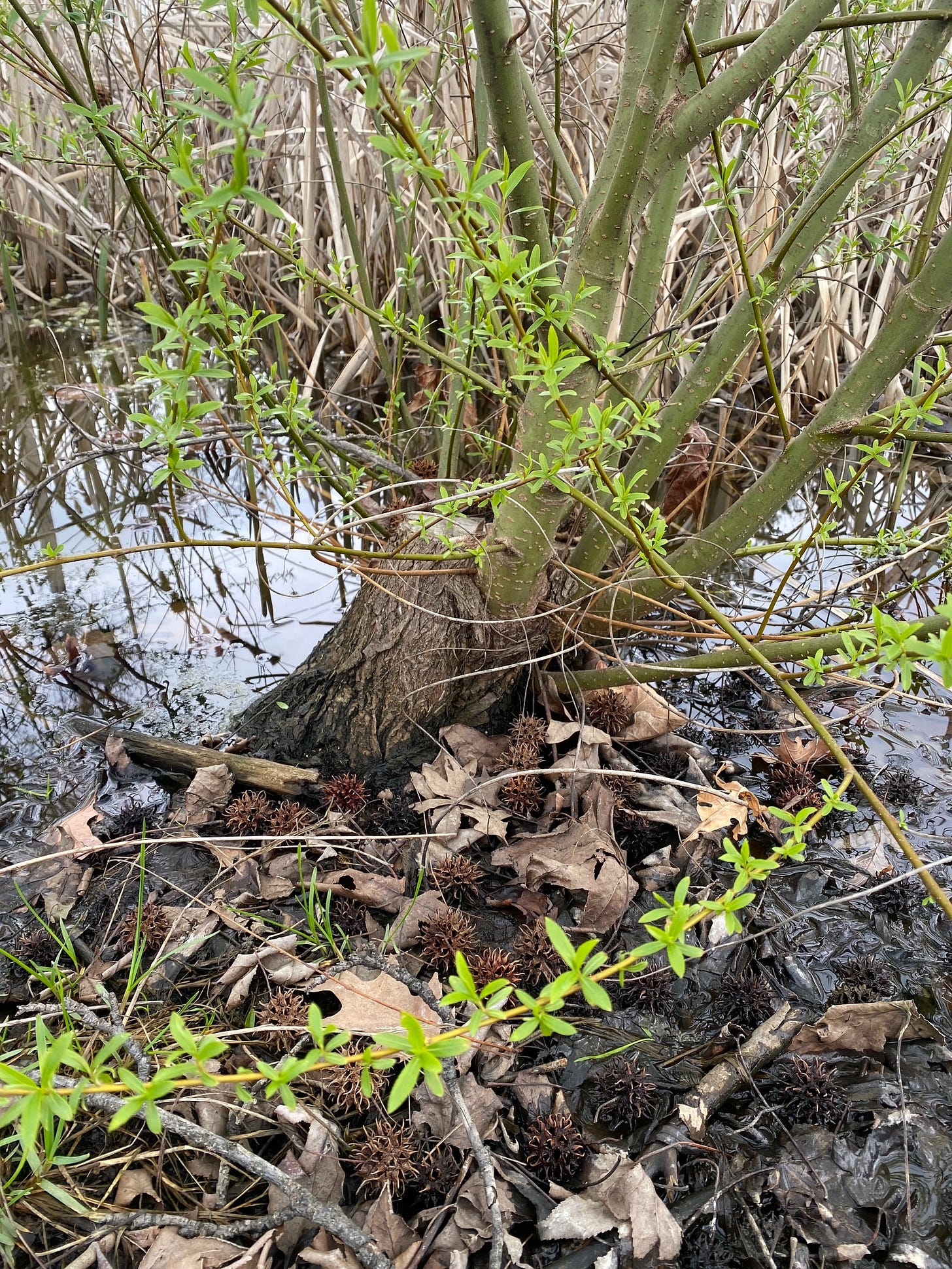
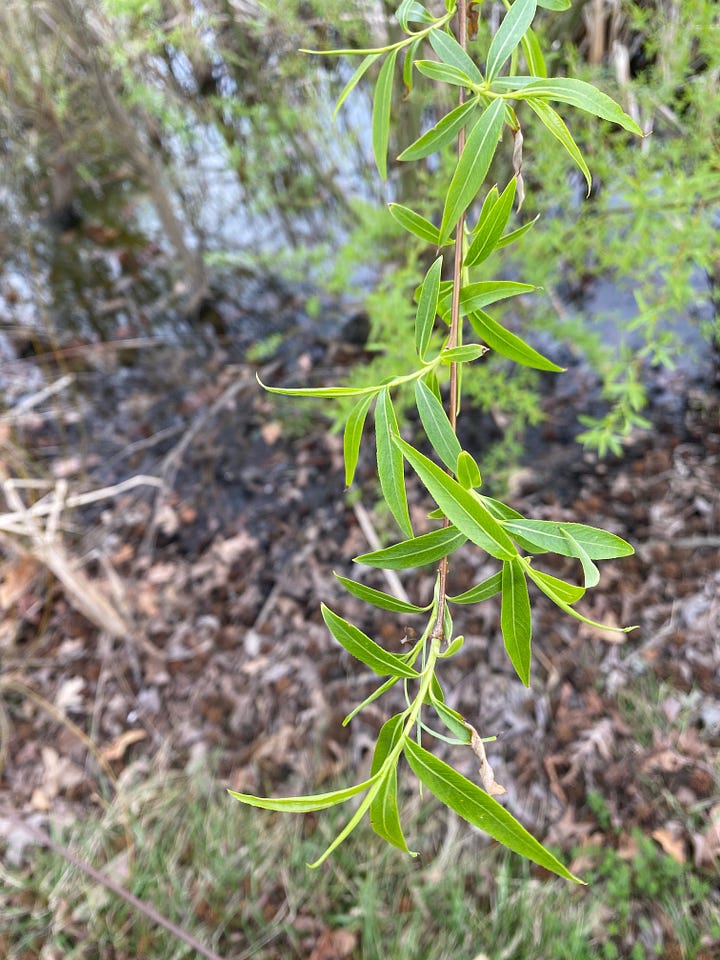
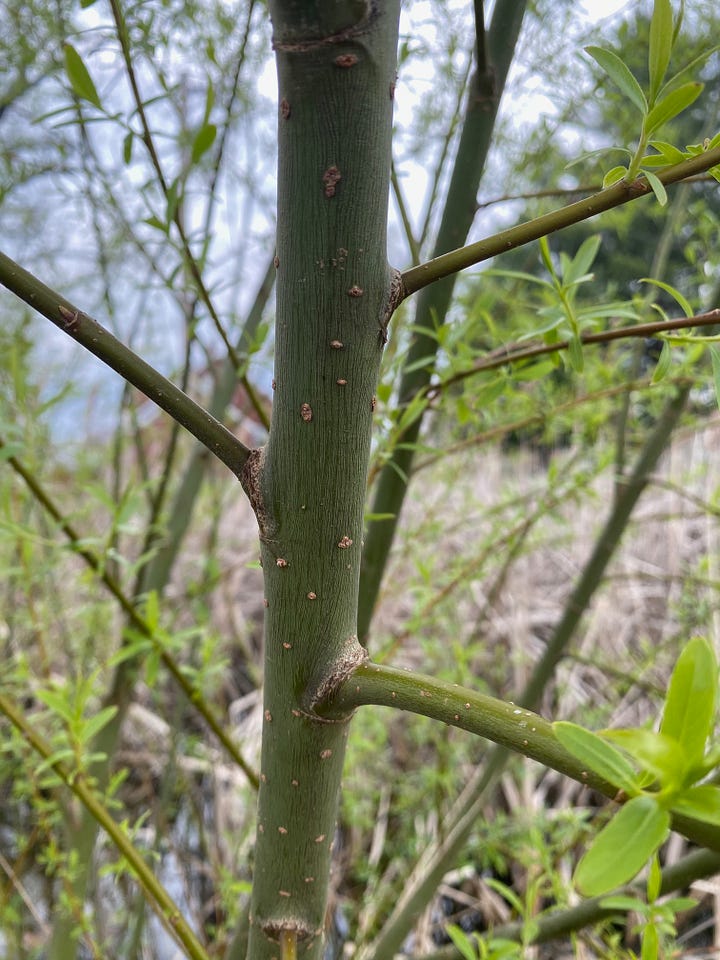
Native to the U.S. is the widespread black willow, Salix nigra, which has somewhat longer leaves, 3-6 inches, which are green on both sides, and darker bark which ranges from light brown with orange tint when young, to dark brown or black, becoming shaggy with age. This large tree is native to the eastern half of North America, but has spread further, and is now observed in California. The border between new growth and old growth on the branches is brittle and can easily be snapped. While the bark of this species can be used similarly to S. alba, the black willow is traditionally known for use of the fresh catkins to address various hypersexual symptoms. Henriette Kress and the Kings American Dispensatory suggested a decoction or tincture of these floral parts for calming urogenital irritations, raging teen hormones, untimely emissions, and even satyriasis and nymphomania. In earlier eras there was a concept that sexual excess could unbalance and interfere with functions of daily living. (Such ideas seem to have faded in modern times, as some have exhibited these aspects of life in road shows, the workplace, and large, public events. Some demand for an-aphrodisiacs could possibly return as a result the swinging social pendulum and rapidly changing health care circumstances.) Henriette Kress suggested macerating 1 part by weight of fresh flower buds from any willow to 2 parts of the strongest possible ethanol solution for 14 days, and a dose of 15 drops of tincture three times daily. (Likely aqueous extraction would not be as efficient as ethanol to obtain phyto-estrogenic compounds, such as isoflavones.)
As mentioned above, Salix alba and S. Nigra don’t produce the highest amounts of salicylates, and these likely cannot account for the entirety of pain relieving effects for which these plants have been popularly used. Various esters of salicylic acid are produced within the plant, such as the glycosides salicin and salicortin. When ingested by us, these are metabolized to saligenin (o-hydroxybenzyl alcohol) in the gut, which is slowly absorbed, and in turn metabolized to salicylic acid in the liver. Salicylic acid has some COX1 and COX2 inhibitory activity in anti-inflammatory pain relief, but this accounts for only part of its action, and it modulates COX2 by more than one pathway. However salicylic acid notably lacks the ability to irreversibly inhibit platelet aggregation, (in contrast to aspirin ( acetyl-salicylic acid), which is commonly used as a blood thinner). The anti-coagulant effects of salicylic acid, and willow bark from which it is generated, are mild (compared to that of aspirin), and therefore it has reduced risk of causing bleeding events. In fact, willow bark and its extracts had been traditionally suggested for gastro-intestinal disruptions, dyspepsia and dysentery, and, due to the astringent effects of its tannins, it has been used to reduce bleeding.
Salacin in willow bark acts as a pro-drug which bypasses the stomach, is slowly converted in the lower gut to an absorbable form, and is finally transformed to its active form in the liver. In many of the willow species, salacin it is a low concentration ingredient that surely is not accounting for all of the effectiveness which has motivated people to strip the inner bark from 2 year and older stems of willow in the spring and fall, and dry it up, or tincture it to treat pain and fever. We are convinced that considerable activity is contributed by the ability of flavonoids and other compounds to decrease myriad other inflammatory processes.
Within the willow genus, over 300 secondary metabolic products have been elucidated among which are
flavonols, flavones, flavanones, isoflavones, flavan-3-ols (catechins and procyanidins), chalcones, dihydrochalcone, anthocyanins, dihydroflavonols,
phenolic glycosides,
organic acids
non-phenolic glycosides,
sterols and terpenes,
simple phenolics,
lignans and tannins
Leaves of willows contain more of the flavonoids found in the first group, above, though some of these are also found in the bark. Lignans are naturally to be more concentrated in the bark, while more of the sterols and terpenes are expected in the flowering parts. Salicylate esters are more likely found in the inner bark, though many species of willows also produce significant amounts of these in the leaves.
Human clinical trials bear out the antipyretic and anti-inflammatory activities of willow, though it is likely too slow acting to address acute attacks of pain such as that produced by gout. Anti-tumor activity and anti-microbial activity has been identified by in-vitro and animal experimentation, with much credit going towards the flavonoids and the phenolics, found in leaves and the bark.
Those with known allergy to aspirin and related drugs, as well as any who have glucose-6-phosphate dehydrogenase (G6PD) deficiency should consider the use of willow products with extreme caution.
You have not heard the last about salicylates in plants and in animals, since these compounds are vital as plant regulatory and defense signalling hormones, and they play surprising and varied roles in animal cellular processes too.
What kind of willows are growing nearest to you, and what are your plans for them? You can employ a willow to drink up any standing water on your land. They’re very easy to propagate by cuttings. Just keep them away from plumbing and drainage pipes. :-D
Where We Dig
1. de la Forêt R, Han E. Wild Remedies - How to Forage Healing Foods and Craft Your Own Herbal Medicine. Hay House Inc.; 2020. https://openlibrary.org/books/OL28333721M/Wild_Remedies
2. White Willow - Salix alba | North Carolina Extension Gardener Plant Toolbox. Accessed April 2, 2024. https://plants.ces.ncsu.edu/plants/salix-alba/common-name/white-willow/
3. Wood M. The Earthwise Herbal. A Complete Guide to NEw World Medicinal Plants. North Atlantic Books; 2009. https://openlibrary.org/books/OL22552057M/The_earthwise_herbal.
4. Wood M. The Earthwise Herbal - A Complete Guide to Old World Medicinal Plants. North Atlantic Books; 2008. https://openlibrary.org/books/OL12031143M/The_Earthwise_Herbal
5. Walsh D. The anti-inflamatory properties of meadowsweet. The Pharmaceutical Journal. Published September 17, 2014. Accessed April 2, 2024. https://pharmaceutical-journal.com/article/opinion/the-anti-inflamatory-properties-of-meadowsweet
6. Feistel F, Paetz C, Lorenz S, Schneider B. The Absolute Configuration of Salicortin, HCH-Salicortin and Tremulacin from Populus trichocarpa × deltoides Beaupré. Molecules. 2015;20(4):5566-5573. doi:10.3390/molecules20045566
7. Gligorić E, Igić R, Suvajdžić L, Grujić-Letić N. Species of the Genus Salix L.: Biochemical Screening and Molecular Docking Approach to Potential Acetylcholinesterase Inhibitors. Applied Sciences. 2019;9(9):1842. doi:10.3390/app9091842
8. Salix nigra (Black Willow) | North Carolina Extension Gardener Plant Toolbox. Accessed April 2, 2024. https://plants.ces.ncsu.edu/plants/salix-nigra/
9. Salix Alba: Benefits, Uses And Remedial Solutions From This Plant To Bolster Skin Health. Netmeds. Accessed April 2, 2024. https://www.netmeds.com/health-library/post/salix-alba-benefits-uses-and-remedial-solutions-from-this-plant-to-bolster-skin-health
10. DerMarderosian A, Buetler J. Review of Natural Products. 8th edition. Lippincott Williams & Wilkins; Facts and Comparisons; 2014. https://openlibrary.org/books/OL27960482M/Review_of_Natural_Products
11. Tawfeek N, Mahmoud MF, Hamdan DI, et al. Phytochemistry, Pharmacology and Medicinal Uses of Plants of the Genus Salix: An Updated Review. Front Pharmacol. 2021;12:593856. doi:10.3389/fphar.2021.593856
12. Nica IC, Mernea M, Stoian G, Dinischiotu A. Natural Aspirin-Like Compounds from White Willow (Salix alba) Bark Extract Prevent Structural Changes of Human Hemoglobin during In Vitro Non-Enzymatic Glycation and Fructation, Preserving Its Peroxidase and Esterase Activity. Medical Sciences Forum. 2020;2(1):23. doi:10.3390/CAHD2020-08602
13. Grieve M. Modern Herbal. Echo Point Books & Media, LLC.; 2015. https://openlibrary.org/books/OL36722889M/Modern_Herbal
14. medicinal herbs: WHITE WILLOW - Salix alba. Accessed April 2, 2024. http://www.naturalmedicinalherbs.net/herbs/s/salix-alba=white-willow.php
15. Hutchens AR. Indian Herbalogy of North America. Shambhala; Distributed in the United States by Random House; 1991. https://openlibrary.org/books/OL1567124M/Indian_herbalogy_of_North_America
16. Dempsey DA, Klessig DF. How does the multifaceted plant hormone salicylic acid combat disease in plants and are similar mechanisms utilized in humans? BMC Biology. 2017;15(1):23. doi:10.1186/s12915-017-0364-8
17. Ganora L. Herbal Constituents, 2nd Edition - Foundations of Phytochemistry. Lulu Press, Inc.; 2021. https://openlibrary.org/books/OL35083771M/Herbal_Constituents_2nd_Edition
18. Herb info 09/2017: Willow. | Henriette’s Herbal Homepage. Accessed April 3, 2024. https://www.henriettes-herb.com/blog/hc-09-2017-willow.html
19. Neagu Codreanu AM, Baicea C, Popescu A, Tomescu J, Bordei N, Raluca S. Bioactive Phenolic Compounds From White Willow (Salix alba) Bark, Leaves And Branches. UPB Scientific Bulletin, Series B: Chemistry and Materials Science. 2021;83:41-50.
20. EMA Assessment Report on Salix [various species including S. purpurea L., S. daphnoides Vill., S. fragilis L.], cortex. Accessed April 2.2024 https://www.ema.europa.eu/en/documents/herbal-report/final-assessment-report-salix-various-species-including-s-purpurea-l-s-daphnoides-vill-s-fragilis-l-cortex_en.pdf



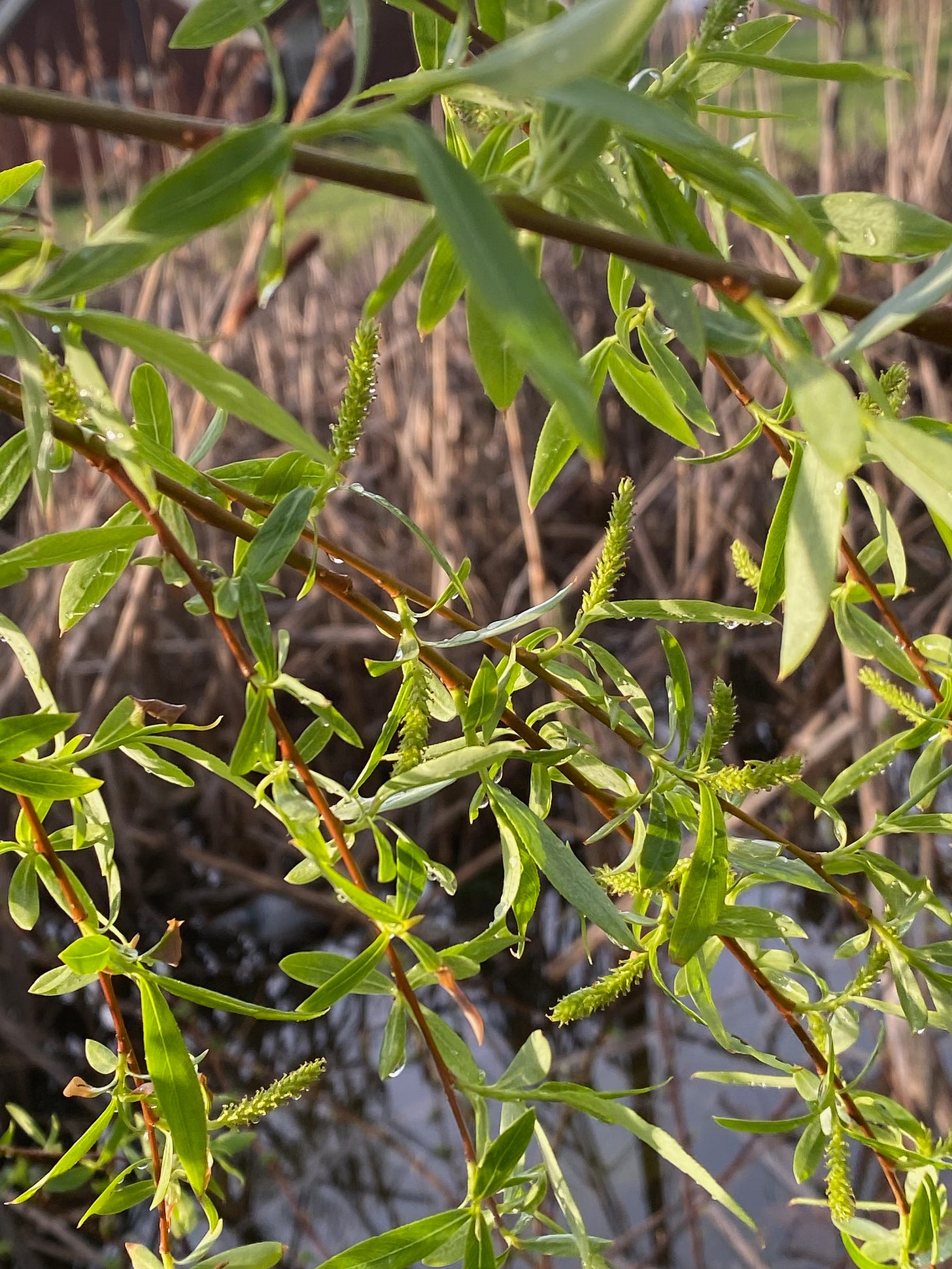
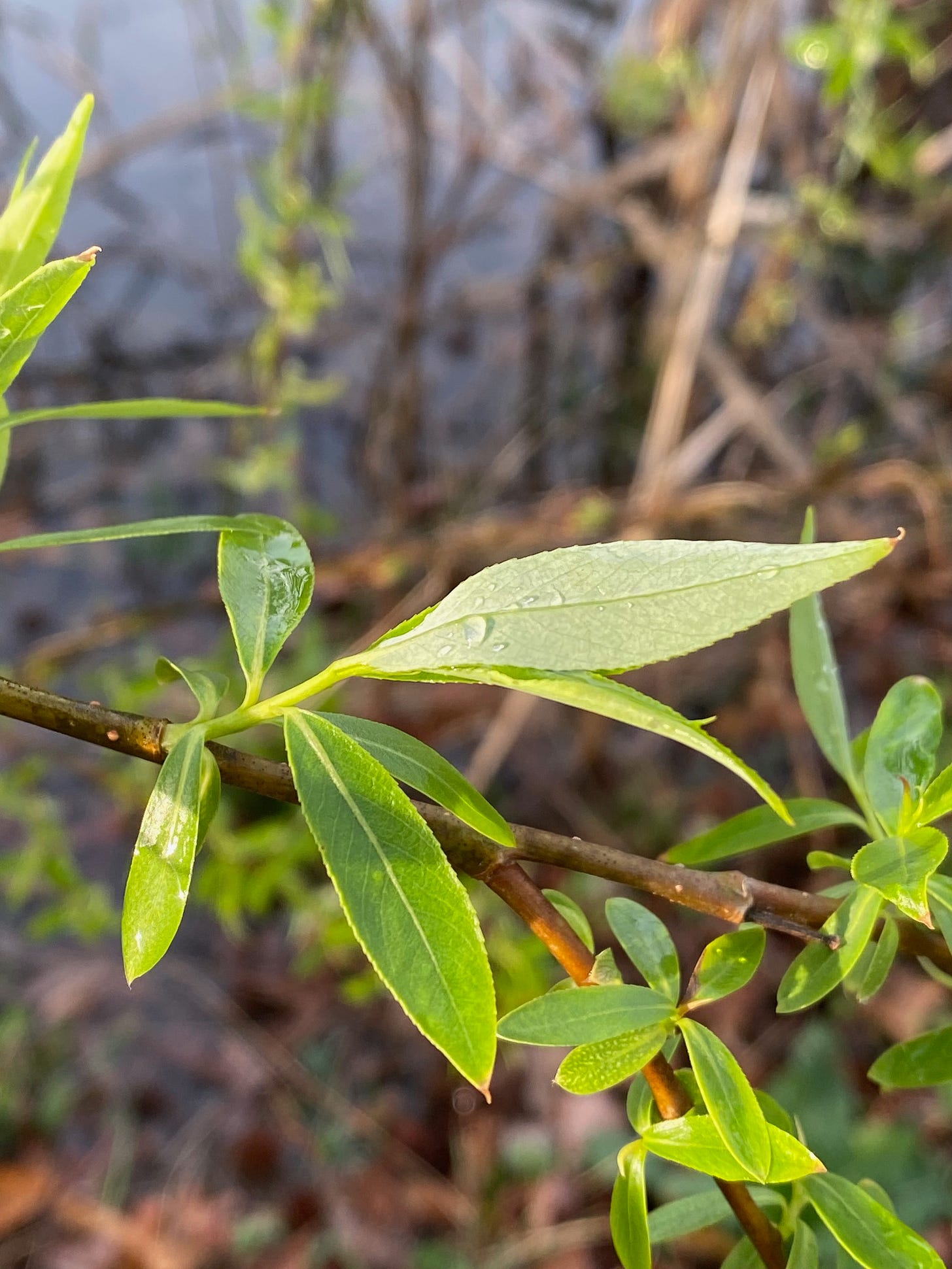


There was a neighbor hereabouts who abused their horses, did not feed them. The horses ate all the bark off the willow trees; I thought the willows were done for. Several years later, you'd never know they had been chewed down so brutally. Willows have almost magical regenerative powers!
I didn’t realize they hybridized like that.